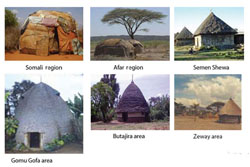4.4 Factors affecting healthful housing
Poverty, education, climate, culture and population mobility are the main factors that affect the structure of housing, i.e. the size, shape and design.
Figure 4.1 shows various types of tukuls (rural housing) that reflect different climatic and cultural variations. Big tukuls have tight-plastered walls and roofs, are more spacious and are usually found in cold areas. Tukuls in pastoralist areas are smaller in size, easily constructed and relatively inexpensive. Mobile populations require housing that can be reconstituted easily whenever needed. Some cultural values may hinder specific requirements such as the use of wider windows. Lack of education is also a problem. Even in high-income households, poor knowledge of the links between housing and health may be a barrier to the construction of healthful housing.
You should note that these factors affecting housing conditions are broad issues and not something that anyone can tackle alone, but you should be aware of these factors because they may be relevant in your villages.
4.3 Protecting people at special risk

